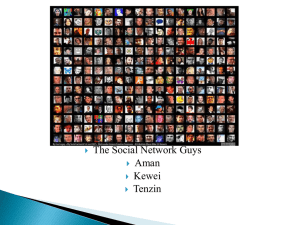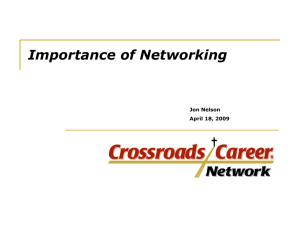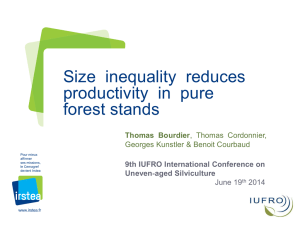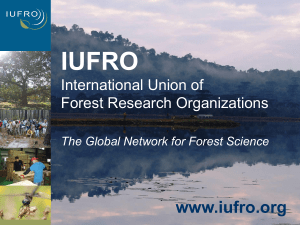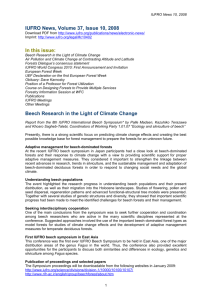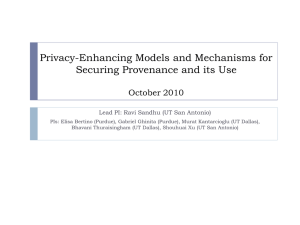Networks with forest genetic field trials. Warzawa 2010.
advertisement
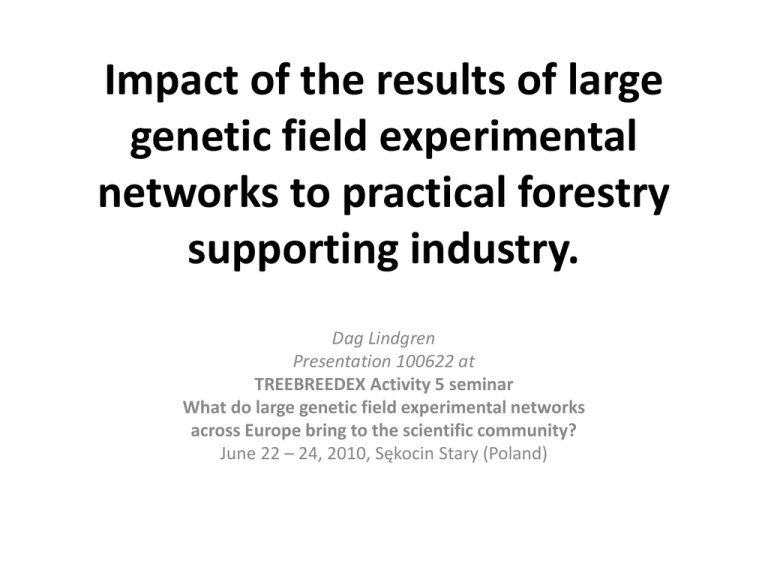
Impact of the results of large genetic field experimental networks to practical forestry supporting industry. Dag Lindgren Presentation 100622 at TREEBREEDEX Activity 5 seminar What do large genetic field experimental networks across Europe bring to the scientific community? June 22 – 24, 2010, Sękocin Stary (Poland) Some expected impacts for Industry • • • • • • • • • More reliable and applicable breeding values Better forest regeneration materials now and in the future Better known and documented forest regeneration materials Reduced risk of failures with FRM Better forecasts of forest growth More discussion and attention focusing on the forest in the field Better contacts among those dealing with similar forests in different organizations (countries) More focus of scientists (like forest geneticists), education and administrators of what happens with industrial plantations Easier to claim that Industry knows something about what they are doing and tries to get it better known (e.g. One organization One organization can afford a few test sites Several networking organizations can afford more test sites Net work of field trials increase the resources and thus accuracy of results • Performances estimated are not as general as desirable. Many sites and replication in time and experimental technique will improve generality. Networks may help with that. P. sylvestris – h2 for tree height at age 10-20 yrs, >200 trials, 6.000 families, 1.000.000 trees Sites are very different genetically! Many sites desirable for reasonable general and reliable BVs! Still more to describe the variation among sites! Modified from Andersson 2009, TREEBREEDEX presentation Orleans Norway spruce provenance performance at four Finnish trial sites Norway spruce Volume production (m3/ha) 40 to 50 yrs age Stands seeds vary among what is typical for the “provenance origin” in an usually unpredictable way. Large trials required to know these residuals better At the X-axis is transfer distance, 0 is local and the higher values is transfers from a location with higher heat sum from Koski 1989 extracted from Ruotsalainen 2008 TREEBREEDEX presentation Pirna Sites are genetically different. More sites improves possibilities to describe how different. Genotype-Environment Interaction If there is a pattern so some material types are relatively better on some site types, this can be utilized to improve gain! Useful such grouping requires generally many sites! Networking improves possibilities! Seeds produced by one organization may be used by another if materials are relevantly tested. 68° Field tests 66° Organisation a 64° Organisation b Organisation c 62° Joint analyses can be made if materials overlap: 60° - Improved BV accuracy - Predictions on untested sites 58° 56° Modified from Andersson 2009 TREEBREEDEX presentation Orleans Calculated inoptimality loss for Scots pine as a function of zone size and origin range at the same altitude Zone size (Latitudes) Range of origins (Latitudes) Loss (%) 4 0 5.3 2 0 1.3 2 2 2.0 2 4 4.0 Conclusions: • Zone size ranging over 2-3 latitudes for a seed orchard is OK • Avoid larger range of origin for clones than 3 latitudes in seed orchards Modified from Lindgren 2009 TREEBREEDEX presentation Hann Münden The message is that areas served by genetic materials extends over organizational (national) borders. For Swedish Scots pine it is somewhat less than two latitudes, thus almost two latitudes south or north of Sweden. The example is an underestimate as Scots pine is sensitive to latitudinal transfer and sensitivity to latitude transfer is less south of Sweden. Imports of Scots pine FRM into Germany Extracted from Liesebach et al 2008 TREEBREEDEX presentation Pirna Norway spruce transfers in Sweden Extends national borders! Modified from Westin 2008 TREEBREEDEX presentation Pirna Exploitation of the genetic resources of a species requires samples from its range tested over its potential use. Networking is required From Pâques 2009 TREEBREEDEX presentation Hann-Münden, 2009 Countries or organization are just not large enough to handle the relevant range of sites or origins When environments changes, the test sites established by one organization may not be the relevant ones. Networks is a preparation and part of the solution to environmental change (Global warming) Environment or demands of organization may change! The most suitable test environments for use of test results may be found outside the organization • since the environments have changed • or the predictions of genetic materials performance has changed • or requirements of production have changed! This is easier to handle if organizations are networking Message: test some common materials together with neighbors and over time, preferable well-defined reproducible “standard materials”, to connect test sites and to improve the value of the network for industry. Global warming is here!!! Networks help to quantify! • Immediately: implement temperature raise half a degree compared to history, but no other climate change, when interpreting test results for choosing FRM! • Immediate action with little risk of overreaction (be a bit conservative) Recommendation Lindgren 2009 TREEBREEDEX presentation Hann-Münden, 2009 Thus, there are reasons to assume networking should be good…but Networking over organizational borders is desired, but does networking requires ready networks? Are not the benefits rather independent of preorganized networks? There are lots of interfaces today, is that not enough? E.g. certainly Sweden has benefitted greatly on European spruce provenances over centuries, (recently mainly from Belarus), but was it really networking of mutual benefit? Does Sweden have a network with Belarus? What was the benefit for Belarus? Now Swedish companies market FRMs in Finland, but is it really thanks to organized networks? Better FRM-directed networks are for the same or similar materials so is it a benefit in networking with countries with different climates and species? E.g. Sweden may need near Russia contacts more than interaction with Spain and Italy. Can not networks complicate matters if they are rigid, timeconsuming and incomplete? At IUFRO World congress 1995 (Finland) I reviewed “provenance trials revisited” and made the following table Table . Some international provenance trials with conifers. Species Establishment Year (may vary within series) Reference (example) Scotch pine 1907-1908 Giertych and Oleksyn (1992) 1938 -"- 1938 Giertych (1976), Krutzsch (1992) 1964/68 Dietrichson et al (1976). Skröppa et al (1993), Persson and Persson (1992), Krutzsch (1992) 1944 Weisgerber and Sindelar (1992) 1958/59 Schober (1985) Pinus contorta 1971 Fletcher and Barner (1978): Lindgren (1993b). Douglas fir 1971 Brunet and Roman-Amat (1987) Sitka spruce 1975 Ying and McKnight (1993) Norway spruce Larch Since 1995 rather little (but something) appeared based on these trial series. Where something appeared the networking character is seldom evident. When something appeared it is seldom focused on the use for practical forestry. Provenance research should still be very relevant for industry. I guess that about half FRM of practical forestry today are more or less stand seeds. In spite of its importance little of the research efforts is on provenance research and still less linked to the IUFRO networks. I looked into the IUFRO structure, which is expected to be the basic instrument for international networking. Once the species working parties were mainly for the international IUFRO trials • 2.00.00 – Physiology and Genetics - a single proceedings with very little genetics • 2.02.00 – Conifer breeding and genetic resources - nothing • 2.02.11 – Norway spruce breeding and genetic resources – one conference (in Poland!! Prof Szabor) three years ago with about six papers referring to IUFRO trials with limited international coverage. • 2.02.18 – Scots pine breeding and genetic resources - nothing My impression is that IUFRO does not fill the role of networking around large networks of genetic field trials well or enough any more. It is a pity as I think IUFRO is the only organization, which can do this networking in a general sense. • Networking connected to field tests should be open (more like IUFRO) and flexible and not closed and fixed (like TREEBREEDEX). In the later case important elements will usually be missing. • Often it is easier to network with people from other organizations than the own organization!!! (a reason for networks!) • Long term field trials have not been winners in University pecking orders or ways to get Scientific Fame. • • • • • There are other things networks could be good for, I mentioned some in the first slide. More discussion and attention focusing on the forest in the field. Wider discussions and more experiences. Better contacts among those dealing with similar forests in different organizations (countries) Discussions Industry-Science. More focus of scientists (like forest geneticists), education and administrators of what happens with industrial plantations Easier to claim that Industry knows something about what they are doing and tries to get it better known So much attention on Industrial plantations would not occur if networks do not have large genetic field experiments in focus. Networks or not! Large genetic field experiments are one of the keys to survival of the human race and civilization! • Without them we do not know what we should do or have done when managing forest land. • Gives a sustainable support for an increasing world population with a reasonable standard of living! • Emphasize on sustainability and basic environment friendliness. The forest creates raw material from air, water and sun-shine. • Demonstration that we care for the future and plan long term. • Basis for predicting the impact of the present and future forest. Thank you - end Photo Ola Rosvall 2009




